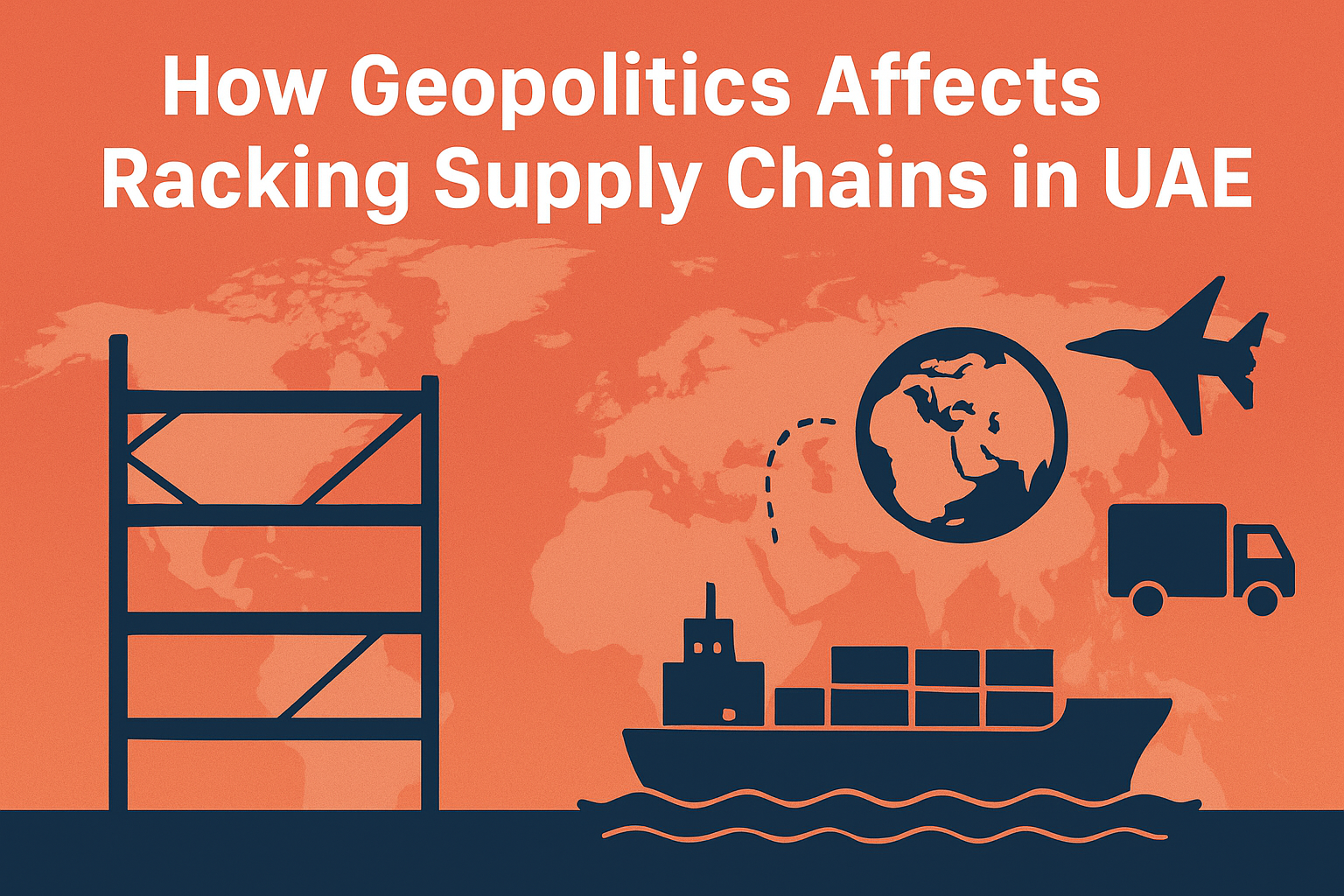
In today’s interconnected world, no industry is immune to geopolitics. For businesses in the UAE, where global trade routes converge, the racking supply chain has become increasingly sensitive to international tensions, sanctions, and policy shifts. From port congestion in Asia to tariffs in Europe, every disruption trickles down into the availability, cost, and delivery timelines of racking systems in the region.
This article explores how geopolitical dynamics directly affect the UAE’s racking supply chain, highlighting risks, strategies, and future outlooks for warehouse operators and logistics firms.
The UAE’s Strategic Role in Global Supply Chains
The UAE is more than just a regional hub; it is a gateway to global trade. With Jebel Ali Port in Dubai serving as one of the busiest in the world, the nation relies heavily on imports of racking materials from steel beams to specialized shelving systems.
- 90% of racking steel components are imported from Asia, Europe, and occasionally North America.
- The UAE’s free zones make it attractive for re-export, meaning supply chain disruptions ripple beyond domestic demand.
- Logistics investments (like Etihad Rail and DP World expansions) position the UAE as a resilience leader.
This dependency on imports means that any geopolitical event whether a tariff, sanctions, or maritime route disruption can directly impact warehouse infrastructure projects.
Key Geopolitical Factors Impacting UAE Racking Supply Chains
1. Trade Wars and Tariffs
The US-China trade war reshaped global steel markets. When tariffs hit Chinese exports, many suppliers redirected products to the Middle East. For the UAE:
- Short-term benefit: Cheaper imports from surplus steel.
- Long-term risk: Market volatility and pricing uncertainty.
2. Sanctions and Export Controls
Global sanctions especially on countries like Russia affect the steel industry.
- Russia, a major steel producer, has faced sanctions that disrupted supply.
- UAE importers had to seek alternative markets, often at higher costs.
3. Maritime Route Disruptions
The Red Sea crisis (Houthi attacks in 2023–2024) caused shipping reroutes around the Cape of Good Hope.
- Shipping costs for steel and racking components to Jebel Ali rose by 30–40%.
- Lead times stretched by weeks, delaying warehouse projects.
4. Oil Prices and Currency Fluctuations
Since racking is steel-intensive, oil and energy price hikes raise production costs globally.
- When oil prices rise, steel manufacturing and transport costs surge.
- Currency fluctuations (like the strong USD) make imports costlier for UAE buyers.
5. Regional Stability in the Middle East
Conflicts or political instability in neighboring regions can quickly impact supply lines.
- The Gulf’s reliance on smooth maritime and air corridors makes stability essential.
Impact on UAE Warehousing & Logistics
The direct consequences of geopolitics on the UAE racking supply chain are clear:
- Rising Costs: Steel price volatility directly impacts project budgets.
- Longer Lead Times: Import delays hinder warehouse expansion.
- Supply Diversification Challenges: Few local manufacturers, so reliance on imports remains high.
- Operational Uncertainty: Businesses face planning challenges when costs and timelines fluctuate.
How UAE Companies Are Responding
1. Supplier Diversification
- Importers are reducing reliance on a single country (e.g., China or Turkey).
- Partnerships with multiple global suppliers are becoming standard.
2. Local Manufacturing Push
- Some UAE free zones are encouraging steel and racking production locally.
- Investment in value-added assembly reduces import dependency.
3. Technology in Supply Chain Management
- AI-driven forecasting helps predict geopolitical risks and shipping delays.
- Digital freight platforms allow companies to pivot routes faster.
4. Strategic Stockpiling
- Many logistics companies now maintain buffer stock of racking systems.
- While storage is costly, it mitigates sudden supply disruptions.
Future Outlook: UAE Racking Supply Chain Amid Global Uncertainty
Experts predict:
- Short-Term (2025–2027): Continued disruptions due to Middle East tensions and global shipping challenges.
- Medium-Term (2027–2032): Growth in local racking production will reduce reliance on imports.
- Long-Term: UAE will remain a resilient logistics hub, leveraging infrastructure, policy, and technology.
For businesses, the lesson is clear: geopolitics is now a core part of supply chain planning.
Expert Recommendations for UAE Businesses
- Build multi-supplier relationships to avoid dependency.
- Invest in risk management tools to anticipate global shifts.
- Explore local sourcing and assembly opportunities.
- Maintain flexible logistics contracts to adapt to reroutes.
- Align with UAE free zone initiatives that promote supply resilience.
FAQs
Q1: Why is the UAE so vulnerable to geopolitical supply chain risks?
Because the UAE imports most of its racking systems and steel materials, it is highly exposed to global trade shifts, tariffs, and shipping disruptions.
Q2: Can local UAE manufacturers replace imports?
Not yet fully. Local production is growing, but specialized racking systems still rely on imported steel and designs.
Q3: How do Red Sea disruptions affect UAE warehouses?
They increase shipping times by 2–4 weeks and raise freight costs, directly delaying warehouse projects and raising expenses.
Q4: What strategies can warehouse operators adopt?
Diversify suppliers, stockpile critical materials, and leverage digital logistics platforms to minimize risks.
Q5: What is the long-term outlook?
The UAE is investing in supply chain resilience, but global geopolitics will always play a role. Companies must embed flexibility in procurement strategies.